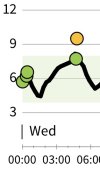I have been using it for the past 4 weeks and I have to say that I am NOT impressed. Its always saying my blood sugar level is way what my finger prick say. For exam, even though its scanning ever time and I can see the realtime graph. I would still manually scan and it would say its 9.7 However, my meter would give a totally different reading of 5.2
This has happened several time to the point am now asking how accurate IS Freestyle Libre ?
But I do love it for the graphs it give, but certainly NOT for the readings !
How have everyone else compared the Freestyle Libre reading to that of finger prick meter ?
(mod edit to say that this post and the following ones have been moved from https://www.diabetes.co.uk/forum/threads/has-anyone-quit-using-freestyle-libre.202578/page-2 so that posters can have a detailed discussion of libre accuracy without derailing that thread. )
This has happened several time to the point am now asking how accurate IS Freestyle Libre ?
But I do love it for the graphs it give, but certainly NOT for the readings !
How have everyone else compared the Freestyle Libre reading to that of finger prick meter ?
(mod edit to say that this post and the following ones have been moved from https://www.diabetes.co.uk/forum/threads/has-anyone-quit-using-freestyle-libre.202578/page-2 so that posters can have a detailed discussion of libre accuracy without derailing that thread. )
Last edited by a moderator:

